
90
Term
Definition
NaturalWater
RetentionMeasure
(NWRM)
NaturalWater RetentionMeasures (NWRM) aremulti-functional measures
that aim to protect andmanagewater resources using natural means and
processes, therefore building upGreen Infrastructure, for example, by
restoring ecosystems and changing land use.NWRM have the potential
to providemultiple benefits, including flood risk reduction,water quality
improvement, groundwater recharge and habitat improvement.As such,
they can help achieve the goals of key EU policies such as theWater
FrameworkDirective (WFD), the Floods Directive (FD) andHabitats and
Birds Directive
NWRM identity card
The EUNWRM Pilot Project has developed fact sheets for individual
NWRM (available at
that present the
available knowledge onNWRM.Drawing from that knowledge, shorter
NWRM ‘identity cards’ have been developed and combined into anNWRM
‘tool box’ to facilitate its access to readers of this guide.Youwill find all
NWRM identity cards in the second part of the guide.
Nature-based solution
Nature-based solutions are understood as living solutions inspired by,
continuously supported by and using nature,which are designed to address
various societal challenges in a resource efficient and adaptablemanner
and to provide simultaneously economic, social and environmental benefits.
)
Retention
Retention is the capacity of (part of) the ecosystem to storewater, nutrients
or sediments, either temporarily or permanently.
Runoff
Surface runoff (also known as overland flow) is the flow of water that
occurs when excess stormwater,meltwater, or other sources flows over
the earth's surface.Thismight occur because soil is saturated to full capacity,
because rain arrivesmore quickly than soil can absorb it, or because
impervious areas (roofs and pavement) send their runoff to surrounding
soil that cannot absorb all of it. Surface runoff is amajor component of the
water cycle. It is the primary agent in soil erosion bywater.
)
RunoffAttenuation
Features (RAFs)
Runoff attenuation features (RAFs) are low-cost, soft-engineered catchment
modifications designed to intercept polluted hydrological flow pathways.
They can be used to slow, store and filter runoff from agricultural (or other)
land in order to reduce flood risk and improvewater quality.
SustainableDrainage
Systems (or SuDS)
Approaches tomanaging surfacewater that take account of water quantity
(flooding),water quality (pollution) and amenity issues are collectively
referred to as SustainableDrainage Systems (SuDS).
SuDS aim tomimic natural runoff and typicallymanage rainfall close to
where it falls. SuDS can be designed to slowwater down (attenuate) before
it enters streams, rivers and other watercourses.They provide areas to
storewater in natural contours and can be used to allowwater to soak
(infiltrate) into the ground, evaporate from surfacewater, or be transpired
from vegetation (known as evapotranspiration). (Source: Susdrain)
Water status
Thewater status represents themain characteristicsofwater bodies as defined
under theEUWFD.TheDirective aims to achieve ‘good status’ for all ground and
surfacewaters (rivers, lakes, transitionalwaters and coastalwaters) in theEU.The
ecological and chemical statusof surfacewaters covers the followingelements:
biological quality (fish,benthic invertebrates,aquaticflora);hydromorphological
quality such as river bank structure, river continuityor substrateof the river
bed;physical-chemical quality such as temperature,oxygenation andnutrient
conditions;and chemical quality that refers toenvironmental quality standards
for river basin specificpollutants.For groundwater, theWFD considers both its
quantitative status and its chemical status.


